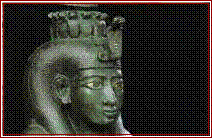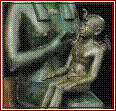
|
To contact us: |







|
Isis and Harpocrates, bronze statuette Egypt |
|
Serapis, Bowman (1986) notes, was a cult with obvious non-Egyptian characteristics, such as Nymphs and the divine personification of abundance, he was also a god that private individuals (Greek and Roman) were permitted to interact with by taking part in religious rites, in other words the priests unlike Egyptians were laymen. This allowed Serapis cults to rapidly develop popular support, particularly since he was associated with healing, and the protection of travellers which encouraged the cult’s spread, as far as Western Sicily by the 2nd century BC (Greaves et al, 1990). The Egyptian cults had piggybacked the spread of Greek eclecticism, with its natural attraction to emotional emphasis, typified by the mystery cults, such as Tyche, the cult of chance, force beyond control. Those who sought answers flocked to these mystery cults, especially that of Isis, who unlike Tyche was associated with Fortuna as bringer of good things rather than blind chance. Initially not all Romans were happy to embrace these new cults. Valerius Maximus (Book I, ch.3) tells of a Roman consul in 50BC who decreed that all Isis shrines should be pulled down, however he could find no willing labourer, so had to undertake the task himself. Initially cult members were made up of the lower classes, immigrants and slaves from the Hellenistic East and so the cult centres were perceived as a focus for disaffection, arousing suspicion amongst the authorities (Hughes-Hallett 1990). Many of the early Italian cult centres were based in Campania, where mercantile connections and large numbers of slaves and freedmen of Greek or Asiatic origin provided a fertile bed for the introduction of non-Italian religions, with only Dionysus worship being on a scale comparable to that of Isis. Strabo had observed that the triad of Serapis, Isis and Harpocrates (Horus) were popular at all levels of society, and the miracle cures reported at the temple of Serapis at Canopus, likewise noted by Tacitus, generated belief in those of the highest merit, but it was to take time to fully integrate the cults into daily Roman life, they needed to be seen as being accepted by the state. Julius Caesar had erected a golden statue of Cleopatra, Isis’ earthly representative, in the temple of Venus the Mother (Venus Genetrix), Plutarch observed that Cleopatra wore, “The robe which is sacred to Isis, and she was addressed as the new Isis.”(Op.Cit. Ch.54). The image of the mother was a positive and attractive one, as indicated by the later construction of the Ara Pacis, but in this case the imagery was deliberate public relations, establishing Cleopatra’s son Caesarion as a god, as Horus, an image repeated on coinage and in reliefs at Denderah, where as Isis she suckles the young Caesarion / Horus (Hughes-Hallett 1990). Cleopatra was employing the cult imagery to sell Caesarion as a fit heir to Egypt and Rome, the true son of a divine father, Caesar. Anthony is later represented as the resurrected Osiris, posing with Cleopatra as Isis for a portrait, and causing Dio Cassius to observe, “This more than anything made him seem to have been bewitched by her through some enchantment.” (Book 50, Ch5). This suspicion of Cleopatra and therefore the cult of Isis in particular does appear to continue throughout the Empire, as is illustrated through the association of Isis and Aphrodite in the form of Isis Pelagia, ‘born on the gleaming waves of the sea’. |